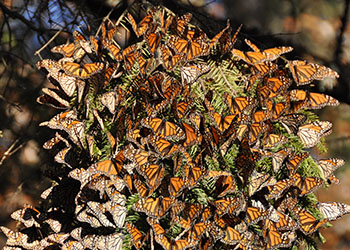On the Flight Path of a Butterfly DNA Researcher
-
-
Slice of MIT
Filed Under
Recommended

Every year, monarch butterflies migrate thousands of miles from the northeastern United States and southern Canada to Mexico, arriving at the same locations as past generations—even though none of the individual insects has been there before. How do they do it?
D. André Green II ’08, an assistant professor of ecology and evolutionary biology at the University of Michigan, Ann Arbor, is diving into the butterfly’s DNA to find out. “Individual butterflies don’t live long enough to make the trip twice, so it must be programmed,” he says.
A biology major at MIT, Green focused on fruit fly genetics for his 2014 PhD at Harvard. Later, as a postdoc at the University of Chicago, he was drawn to monarch research in part because he hoped to tap into the butterfly’s popularity to engage more people in science.
At that point, the monarch also presented a new opportunity for genetic research, since the butterfly’s genome had just been sequenced in 2011. Today, Green’s work involves using tools such as CRISPR to make very precise changes to the monarch’s genome and assess how that affects behaviors such as migration.
“Migration seems so complicated. How does something like that come about?”
 It’s a big, unanswered question—the kind Green loves best, even though he knows he’ll hit some dead ends along his research path. “As I tell my students, if there is no chance of failure at all, maybe the idea isn’t big enough,” he says. “One of the broadest things I got from MIT is being completely unafraid to make mistakes.”
It’s a big, unanswered question—the kind Green loves best, even though he knows he’ll hit some dead ends along his research path. “As I tell my students, if there is no chance of failure at all, maybe the idea isn’t big enough,” he says. “One of the broadest things I got from MIT is being completely unafraid to make mistakes.”
A native of Opelousas, Louisiana, Green set his sights on the Institute early, inspired by watching Independence Day, a film in which Jeff Goldblum plays an MIT grad whose computer code saves the world.
Green also dove into hands-on experiments as a child. Following in the path of his older sister, whose fourth-grade science project gave him his first glimpse of science in action, he progressed over time from testing the longevity of lightbulbs in elementary school to investigating the kidney function of rats in high school (with the help of a professional researcher).
He finally got to the MIT campus during his junior year of high school when he attended the Research Science Institute summer program; he was quickly hooked. “What stood out most from that summer was recognizing how incredibly welcoming and diverse of a place MIT was going to be. Nothing was too weird or out there,” he says. “That provides a lot of freedom to be oneself.”
As I tell my students, if there is no chance of failure at all, maybe the idea isn’t big enough.
As an undergraduate, Green served as president of both the Black Students’ Union and the Biology Undergraduate Student Association; he also spent a lot of time in the Rainbow Lounge. After graduation, he served as an instructor at MIT’s SEED Academy (now known as MITES Saturdays) and discovered he loved teaching. “I was super inspired by the students,” he says. “It started me on this trajectory.”
He joined the faculty at the University of Michigan in 2020, where his work is continuing to contribute to a fuller understanding of the monarch. Already, Green’s research has revealed that cold temperatures serve as a critical prompt to migratory behavior—upending the assumption that longer days and warm weather provide the most important cues for monarchs’ return migration. This research, which Green began at the University of Chicago, also used gene expression analysis to identify clues about a molecular basis for the timing of migration.
These days, Green is collaborating with colleagues at the University of Michigan and University of Pittsburgh to track individual monarchs and investigate butterflies’ behavior at different locations along their migration route. “We’re starting to move into what is changing in the brain—what cues are they paying attention to, and how are they switching these behaviors on and off?” he says. “That’s a really exciting line of experiments.”
Green credits his MIT education with preparing him well for the work. “I have a strong foundation across different sciences, and that’s been useful to how I think about questions and approach them,” he says.
Photo (top): Daryl Marshke/University of Michigan Photography
Photo (inset): D. André Green II







